Horses stay warm in winter by growing a thicker coat with a dense, soft undercoat and longer, coarser guard hairs that create pockets of air that trap heat. They also have the ability to adjust the angle of their hairs to regulate their insulation. Horses with darker coat colors absorb more sunlight and heat, which provides an additional source of warmth, while proper grooming, winter diet, access to shelter, and exercise also help them stay warm.
As the chilly winds of winter start to blow, you might find yourself wondering how your trusty equine friend stays warm in the frosty weather.
Though horses have evolved to adapt to cold temperatures, it’s essential for horse owners to understand their animals’ needs and how to support them during the colder months.
In this article, we’ll explore how horses stay warm in the winter through their winter coat, digestion, and behavioral adaptations, as well as the role of horse owners in ensuring their horses’ well-being during these colder months.
Blanketing Myths and Tips Video
- Blanketing Myths and Tips Video
- Insulation and Piloerection Of The Horse’s Coat
- Coat Colors and Their Role in Keeping A Horse Warm
- The Concept of Lower Critical Temperature
- Factors Influencing a Horse’s Comfort in Cold Weather
- Monitoring Your Horse’s Comfort Levels
- The Role of Fiber in Generating Heat
- Importance of Quality Hay in Your Horse’s Diet
- Calories, Fat Reserves, and Heat Generation
- Body Condition and Movement
- The Role of Sunlight and Natural Shelter
- Huddling Behavior and the Benefits of Horses in Herds
- Choosing the Right Rug
- Regular Rug Checks and Maintenance
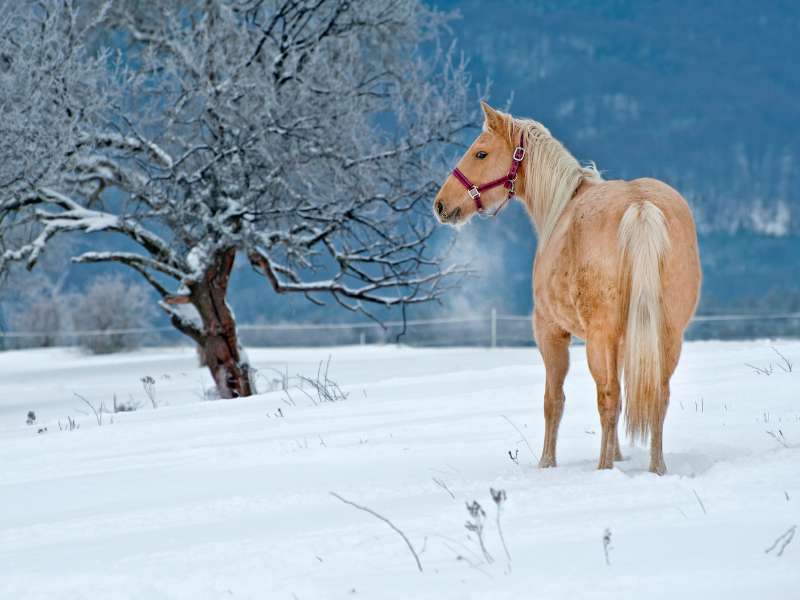
The Science of a Horse’s Winter Coat
One of the key ways horses stay warm during winter is through their unique winter coat. Let’s explore the science behind it, focusing on insulation and the role of coat colors.
| Concept | Explanation |
|---|---|
| Insulation | The winter coat of horses acts as a natural insulator, trapping warm air close to the horse’s skin and keeping them warm. This is possible due to the phenomenon of piloerection. |
| Piloerection | Tiny muscles attached to each hair follicle contract, causing the hair to stand upright, creating pockets of air between the hairs. These air pockets trap heat generated by the horse’s body, helping to maintain their body temperature even in cold weather. |
| Coat Thickness | The thickness of a horse’s winter coat varies depending on the breed, age, and individual characteristics of the animal. Horses that are native to colder climates have thicker, more insulating coats. |
| Hair Types | The winter coat is made up of a dense, soft undercoat and longer, coarser guard hairs, which provides an effective barrier against the cold, wind, and moisture. |
| Hair Angle | Horses can regulate the insulating properties of their coat by adjusting the angle of their hairs in response to changes in temperature. When it’s cold, the hairs stand up to increase the amount of trapped warm air, providing better insulation. |
| Proper Grooming | Regular brushing helps remove dirt, dead hair, and sweat, which can mat the coat and reduce its insulating properties. By keeping the coat clean and well-groomed, the horse can efficiently regulate its body temperature and maintain comfort throughout the winter months. |
| Coat Color | Darker coat colors, such as black or dark brown, absorb more sunlight and heat than lighter colors like grey or palomino. Horses with darker coats can benefit from the sun’s warmth more effectively, providing them with an additional source of heat during the winter months. |
| Visibility | Horses with darker coats are more visible to their peers in low light conditions, such as during dawn and dusk. This increased visibility can be beneficial in terms of social interaction and communication within the herd. |
| Camouflage | In snowy landscapes, lighter-colored horses can blend in more effectively with their surroundings, providing them with a degree of protection from predators. Horses with darker coats may have an advantage in environments with limited snow cover or in wooded areas where their dark coloration helps them blend in with the shadows. |
Insulation and Piloerection Of The Horse’s Coat
The winter coat acts as a natural insulator, trapping warm air close to the horse’s skin and keeping them warm. This insulation is possible because of a phenomenon called piloerection.
Simply put, piloerection is the process by which tiny muscles attached to each hair follicle contract, causing the hair to stand upright.
When the hairs on a horse’s coat stand up, they create pockets of air between them. These air pockets trap heat generated by the horse’s body, helping to maintain their body temperature even in cold weather.
There are additional factors that enhance the effectiveness of this phenomenon.
The thickness of a horse’s winter coat varies depending on the breed, age, and individual characteristics of the animal. Generally, horses that are native to colder climates have thicker, more insulating coats.
As winter approaches and temperatures begin to drop, horses start to grow their winter coat, which is made up of two types of hair: a dense, soft undercoat and longer, coarser guard hairs.
The combination of these hair types provides an effective barrier against the cold, wind, and moisture.
Moreover, horses can regulate the insulating properties of their coat by adjusting the angle of their hairs in response to changes in temperature.
When it’s cold, the hairs stand up to increase the amount of trapped warm air, providing better insulation. On the other hand, when the temperature rises or the horse is overheating, the hairs lie flatter against the body, allowing heat to escape and preventing the horse from getting too hot.
It’s important to note that proper grooming plays a significant role in the effectiveness of a horse’s winter coat insulation. Regular brushing helps remove dirt, dead hair, and sweat, which can mat the coat and reduce its insulating properties. By keeping the coat clean and well-groomed, the horse can efficiently regulate its body temperature and maintain comfort throughout the winter months.
Key Takeaways:
- Horses stay warm in winter due to their winter coat, which acts as a natural insulator by trapping warm air close to the skin.
- Piloerection, which is the contraction of tiny muscles attached to each hair follicle, causes the hairs on the coat to stand upright and create pockets of air that trap heat.
- Proper grooming is crucial for maintaining the effectiveness of the winter coat insulation by removing dirt, dead hair, and sweat that can reduce its insulating properties.
Coat Colors and Their Role in Keeping A Horse Warm
You might wonder if the color of a horse’s coat plays any role in keeping them warm. In fact, it does.
Darker coat colors, such as black or dark brown, absorb more sunlight and heat than lighter colors like grey or palomino.
This means that horses with darker coats can benefit from the sun’s warmth more effectively, providing them with an additional source of heat during the winter months.
While darker coat colors can absorb more sunlight and heat, this is just one element of a horse’s overall strategy for staying warm. Horses with lighter coat colors, still rely heavily on the insulating properties of their winter coat and other cold-weather adaptations to maintain their body temperature.
Interestingly, the color of a horse’s coat can also influence how they are perceived by their herd mates.
For example, research has shown that horses with darker coats are more visible to their peers in low light conditions, such as during dawn and dusk. This increased visibility can be beneficial in terms of social interaction and communication within the herd, potentially leading to more opportunities for huddling together and sharing warmth during cold weather.
Furthermore, coat color can play a role in camouflaging horses from potential predators in their natural environment. In snowy landscapes, lighter-colored horses can blend in more effectively with their surroundings, providing them with a degree of protection from predators.
On the other hand, horses with darker coats may have an advantage in environments with limited snow cover or in wooded areas where their dark coloration helps them blend in with the shadows.
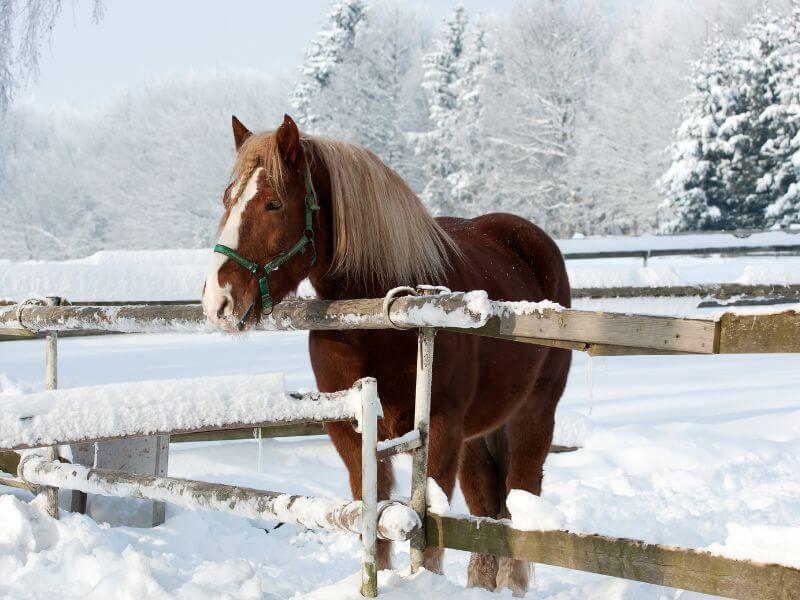
Understanding Your Horse’s Thermoneutral Zone
It’s essential to understand the concept of a horse’s thermoneutral zone.
This comfort zone plays a significant role in how horses adapt to cold weather and maintain their body heat without using extra energy.
We will dive into the concept of the lower critical temperature, the factors that influence a horse’s comfort in cold weather, and how to monitor their comfort levels. This information will help you better understand and support your horse’s well-being during the chilly winter months.
The Concept of Lower Critical Temperature
Understanding the thermoneutral zone is crucial for maintaining a horse’s comfort in cold weather. This temperature range is where a horse can maintain its body heat without expending extra energy.
Essentially, it represents the horse’s ideal temperature conditions.
The lower critical temperature marks the lowest point within the thermoneutral zone, below which a horse needs to use additional energy to stay warm.
For most horses, this point typically lies around 41°F (5°C), though it can vary depending on factors such as breed, age, and body condition.
Factors Influencing a Horse’s Comfort in Cold Weather
Several factors can impact a horse’s comfort level in cold weather, including:
- Breed: Some breeds are more naturally adapted to cold climates, like Icelandic or Norwegian Fjord horses.
- Age and health: Younger or older horses, as well as those with health issues, may have a harder time maintaining their body heat.
- Body condition: Horses with more fat or muscle may have an easier time staying warm.
- Coat: A thicker winter coat provides better insulation.
- Nutrition and hydration: Adequate food and water intake helps generate internal heat.
- Shelter: Access to natural or man-made shelter can protect horses from wind, rain, and snow.
Monitoring Your Horse’s Comfort Levels
| Signs of Discomfort in Cold Weather | Possible Causes | Actions to Take |
|---|---|---|
| Shivering | Inadequate insulation, low body heat | Provide extra blankets, increase feed intake |
| Lifting feet | Cold ground or snow, frostbite risk | Provide dry, warm bedding or footing |
| Tucking tail close to the body | Attempting to conserve body heat | Ensure adequate shelter and insulation |
| Weight loss or visible ribs | Insufficient calories to maintain body heat | Increase feed intake, provide high-quality hay |
| Reluctance to move or stiffness | Cold muscles or joints, decreased circulation | Encourage movement, provide a warmer environment |
| Huddling with other horses | Seeking warmth from other horses | Check individual horses for comfort, provide additional warmth if needed |
To guarantee your horse’s comfort during the colder months, it’s crucial to closely monitor their behavior and physical condition.
Keep an eye out for indications that they might be struggling to stay warm, such as shivering, lifting their feet, or tucking their tail close to their body.
These signs might suggest that they require additional help to maintain their body heat.
Regularly assessing your horse’s body condition is vital. Gently feel for their ribs to detect any weight loss, which could signal that they need more calories to stay warm.
Ensure they receive a well-balanced diet that includes good-quality hay, which is particularly important in winter as it not only provides essential nutrients but also generates internal heat during digestion.
Provide a constant supply of fresh water to keep your horse well-hydrated, as dehydration can make it difficult for them to regulate their body temperature.
Providing appropriate shelter from the elements is equally important. Whether it’s a natural shelter such as trees or a man-made structure like a stable, make sure your horse has a place to escape harsh wind, rain, or snow. This refuge can significantly improve their comfort level during cold weather.
Additionally, it’s essential to maintain open communication with your veterinarian. If you have concerns about your horse’s comfort, health, or any signs of distress during winter, seek their professional advice. They can offer guidance on proper care, feeding, and potential interventions to keep your horse healthy and comfortable throughout the season.
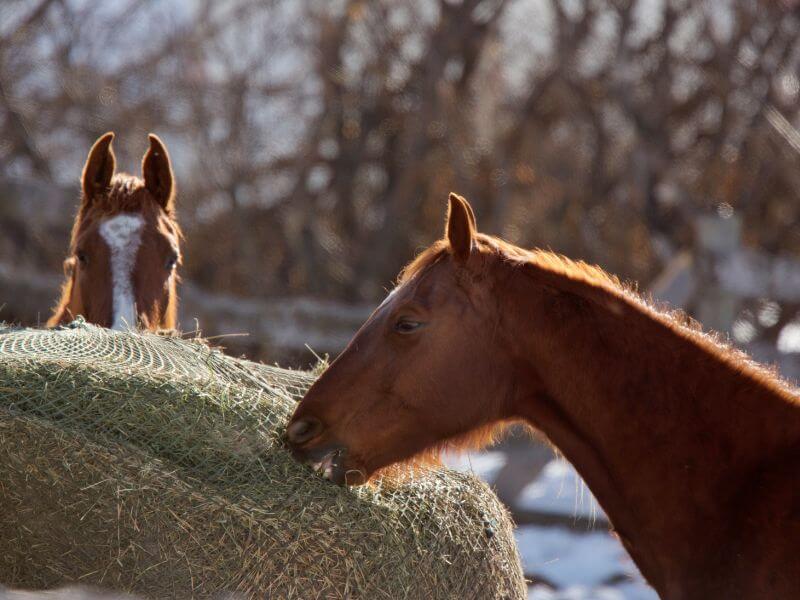
Horse’s Digestion As Heat Production
One of the fascinating ways horses stay warm during the cold winter months is through their digestive system. The process of digestion generates heat internally, which helps them maintain their body temperature.
Let’s explore the role of fiber in producing heat, the importance of quality hay in a horse’s diet, and how calories and fat reserves contribute to heat generation.
| Key Point | Summary |
|---|---|
| Role of Fiber in Generating Heat | Fiber, found in plants like grasses and hay, is crucial for heat generation in horses. During digestion, fiber undergoes fermentation in the large intestine, releasing heat that warms the horse’s body from the inside. Providing adequate high-fiber forage is essential for keeping horses warm during cold weather. |
| Importance of Quality Hay in Horse’s Diet | Quality hay, which is green, sweet-smelling, free of mold and dust, and rich in nutrients, is vital for proper digestion and heat production in horses. Poor-quality hay can lead to health issues and insufficient heat production. To ensure quality, buy from a reputable supplier, store hay properly, and regularly inspect it for signs of mold. |
| Calories, Fat Reserves, and Heat Generation | Horses need more calories during winter to generate extra heat. An increased caloric intake helps maintain body condition and fat reserves, which serve as insulation and an additional source of energy. Subcutaneous fat insulates by trapping heat close to the body. If a horse struggles to stay warm, consult a professional to adjust their diet. |
The Role of Fiber in Generating Heat
Fiber is a crucial component in a horse’s diet, especially during winter. It is found in plants such as grasses and hay, which make up the majority of a horse’s forage intake. The reason fiber is so important in generating heat is because of the way it is broken down during digestion.
When a horse consumes fiber-rich forage, it reaches the horse’s large intestine, specifically the cecum and colon.
In these areas, the fiber undergoes fermentation, a process where microbes break down the fibrous plant material. This process releases energy in the form of heat, which contributes to warming the horse’s body from the inside out.
Therefore, providing your horse with an adequate amount of high-fiber forage is essential for keeping them warm during cold weather.
Importance of Quality Hay in Your Horse’s Diet
Hay is a vital component of a horse’s diet, particularly during winter when fresh grass is scarce. It provides the necessary fiber for proper digestion and heat production. However, not all hay is created equal, and it’s crucial to ensure that the hay you’re providing your horse is of good quality.
Quality hay should be green in color, have a sweet smell, and be free of mold and dust. It should also be rich in nutrients and easily digestible.
Feeding your horse poor-quality hay can lead to various health issues, including respiratory problems and colic.
Moreover, low-quality hay doesn’t provide the same level of heat production during digestion as good-quality hay does, which can make it harder for your horse to stay warm in the winter.
To ensure your horse gets the best hay possible, consider buying from a reputable supplier, and store the hay in a dry, well-ventilated area to prevent mold growth. Regularly inspect the hay for signs of mold or contamination, and discard any hay that doesn’t meet the quality standards.
Calories, Fat Reserves, and Heat Generation
In addition to fiber, calories and fat reserves play a significant role in keeping horses warm during winter. Calories are the units of energy found in the food your horse consumes. When your horse digests its food, the calories are used for various bodily functions, including maintaining body temperature.
During winter, horses require more calories to generate extra heat needed to stay warm. It’s essential to adjust your horse’s diet accordingly, providing them with more energy-rich food sources such as high-quality hay and concentrates.
This increased caloric intake will help them maintain their body condition and fat reserves, which serve as insulation and an additional source of energy.
Fat reserves, especially the subcutaneous fat layer beneath the skin, serve as an effective insulator, trapping heat close to the horse’s body. When a horse has sufficient fat reserves, they can better tolerate cold temperatures. If your horse appears to be losing weight or struggling to stay warm, consult a veterinarian or equine nutritionist for guidance on adjusting their diet to meet their increased energy needs during winter.
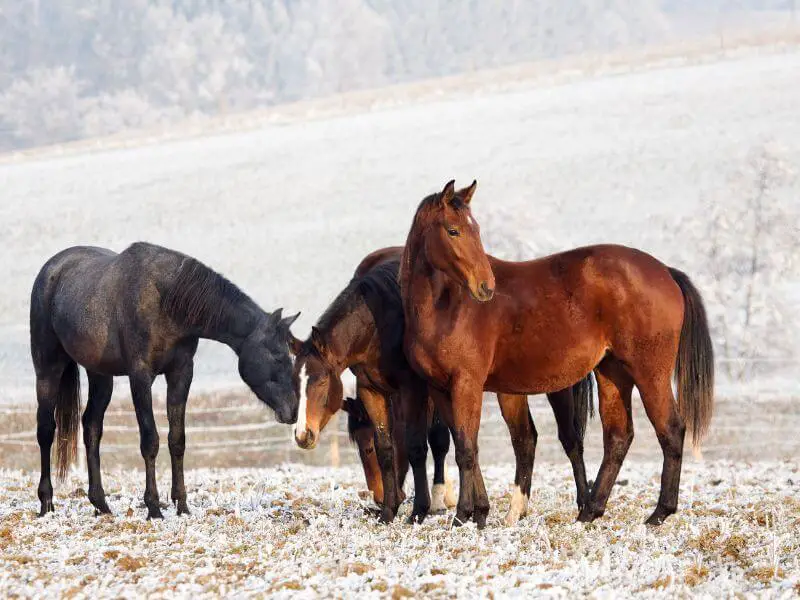
Additional Strategies Horses Use To Keep Warm
Horses are incredibly resilient animals, capable of surviving harsh winter conditions. To do so, they employ a variety of strategies beyond their winter coats to stay warm and comfortable.
Let’s look at three other strategies which include maintaining a healthy body condition and engaging in movement, making use of sunlight and natural shelter, and huddling together in herds.
Body Condition and Movement
Another crucial factor that helps horses stay warm during the winter months is their body condition. A horse with an adequate amount of body fat has a natural insulation layer that retains heat and keeps them warm.
A healthy body condition also ensures that the horse has enough energy reserves to generate heat internally, a process known as thermogenesis.
In addition to maintaining a healthy body condition, movement plays a vital role in keeping horses warm.
When horses move around, their muscles generate heat as a byproduct of activity. This heat warms the body and helps maintain their core body temperature.
As a result, it’s essential for horses to have access to areas where they can move around and exercise, even in cold weather.
The Role of Sunlight and Natural Shelter
Sunlight is another valuable source of warmth for horses during winter. On sunny days, horses can often be seen standing or lying down in sunlit areas to soak up the heat.
The sun’s rays warm their bodies and help maintain their core body temperature. In addition to the direct heat from the sun, solar radiation can also help warm the ground or objects in the environment, providing a secondary source of warmth for the horses.
Natural shelter, such as trees and bushes, can provide protection from wind and precipitation, which are significant factors in how cold a horse feels.
When horses have access to a natural shelter, they can take advantage of its protection to stay warm and dry. In some cases, man-made shelters such as windbreaks or run-in sheds can also offer similar benefits.
Providing horses with access to sheltered areas allows them to conserve energy and stay warm more efficiently.
Huddling Behavior and the Benefits of Horses in Herds
Horses, being social animals, often live in groups or herds. This social structure not only benefits them in terms of companionship and safety but also provides an advantage when it comes to staying warm.
One of the behaviors that horses exhibit to keep warm is huddling together. By standing close to one another, they can share body heat and minimize heat loss to the environment.
Huddling is particularly beneficial during periods of strong wind or extreme cold, as the combined warmth of the horses can create a microclimate that is significantly warmer than the surrounding air.
Additionally, the physical contact between horses can help stimulate blood circulation, further contributing to their overall warmth.
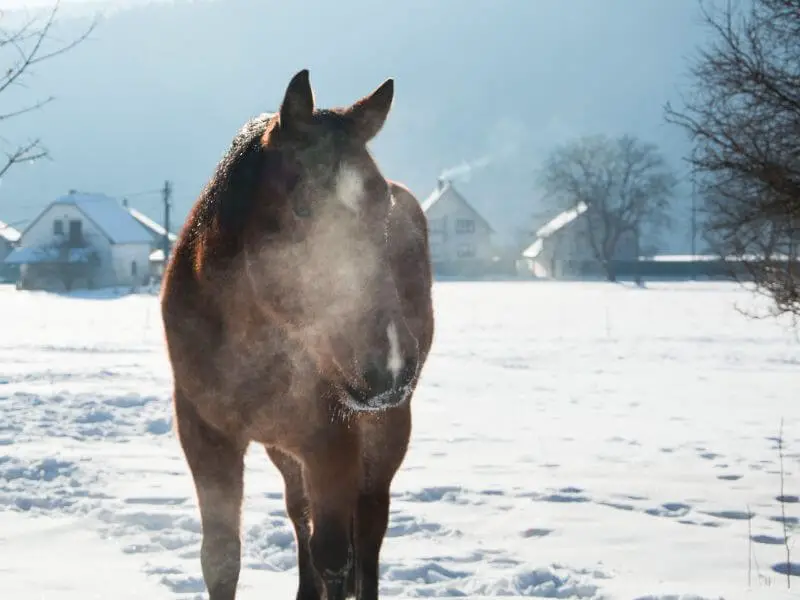
The Respiratory System’s Role in Warming Air
As horses breathe in cold air, their respiratory system plays a vital part in warming and humidifying the air before it reaches the lungs. This process helps protect the delicate tissues within the lungs and ensures that the horse can maintain its core body temperature even in cold environments.
The respiratory system of a horse is made up of several parts, including the nostrils, nasal passages, pharynx, larynx, trachea, bronchi, and lungs. When a horse breathes in cold air through its nostrils, the air first enters the nasal passages.
These passages are lined with a moist mucous membrane containing a dense network of blood vessels. As the cold air moves over the warm, moist surfaces of the nasal passages, it picks up heat and moisture from the blood vessels and mucous membrane.
This heat exchange process, known as convection, effectively warms the air before it continues down the respiratory tract. Additionally, the moisture picked up by the air helps humidify it, preventing the lungs from becoming too dry.
By the time the air reaches the lungs, it is significantly warmer and more humid than when it was first inhaled, protecting the delicate lung tissue from damage caused by cold, dry air.
The warming and humidification of inhaled air is not only essential for the health and function of the horse’s lungs but also plays a role in maintaining the horse’s overall body temperature. When horses exhale, they release warm, moist air back into the environment.
This heat loss through the respiratory system is a normal part of thermoregulation, or the process by which animals maintain their core body temperature.
However, by warming the inhaled air before it reaches the lungs, the horse’s respiratory system helps minimize the overall heat loss through breathing, allowing the animal to conserve more of its body heat in cold conditions.
Key Takeaways:
- The respiratory system warms and humidifies cold air before it reaches the lungs.
- The nasal passages contain a moist mucous membrane and blood vessels, which transfer heat and moisture to the inhaled air.
- The warming process protects delicate lung tissues and helps maintain the horse’s core body temperature.
- Heat loss through breathing is minimized, allowing the horse to conserve more body heat in cold conditions.
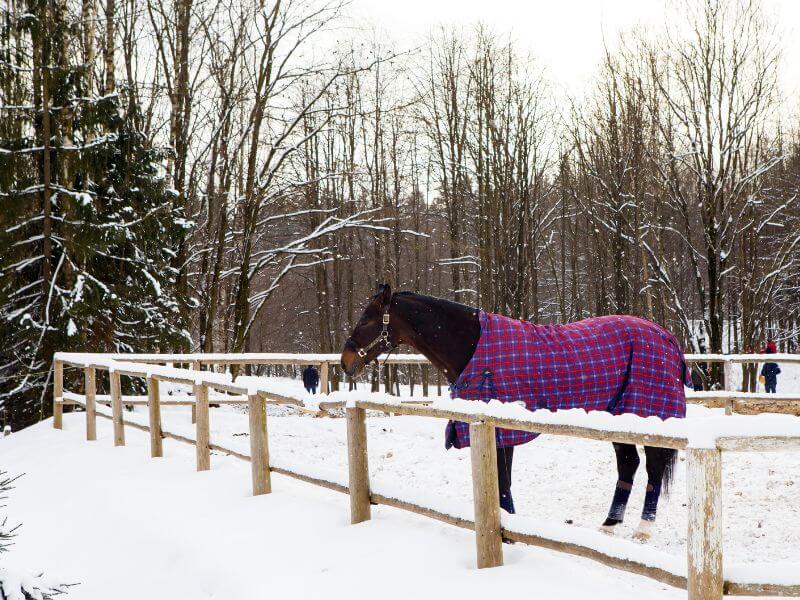
The Role of Rugs and Blankets
If your horse’s coat isn’t providing enough insulation, you might consider using a rug or blanket to keep them warm. When choosing a rug, you’ll want to consider factors such as the horse’s size, activity level, and the weather conditions in your area.
It’s essential to regularly check and remove rugs to ensure your horse stays comfortable and healthy.
Choosing the Right Rug
There are many types of horse rugs and blankets available, each designed for different purposes and weather conditions. Some factors to consider when selecting a rug include:
- Weight: Rugs come in various weights, from lightweight “sheets” to heavyweight “turnout” rugs. Choose a weight appropriate for the temperature and your horse’s needs.
- Breathability: Look for rugs made from breathable materials to prevent your horse from overheating or becoming sweaty under the rug, which can lead to chills.
- Waterproofing: If your horse will be outside during rain or snow, choose a waterproof rug to keep them dry and maintain the insulating properties of their coat.
- Fit: A well-fitting rug is essential for your horse’s comfort and safety. Ensure the rug fits snugly but allows for freedom of movement, and check for rubbing or chafing regularly.
Regular Rug Checks and Maintenance
It’s crucial to check your horse’s rug regularly to ensure it remains in good condition and fits properly. If your horse’s coat becomes wet or dirty under the rug, remove it and allow the coat to dry before replacing it.
Also, check for any signs of rubbing, chafing, or discomfort, and adjust the fit as needed.
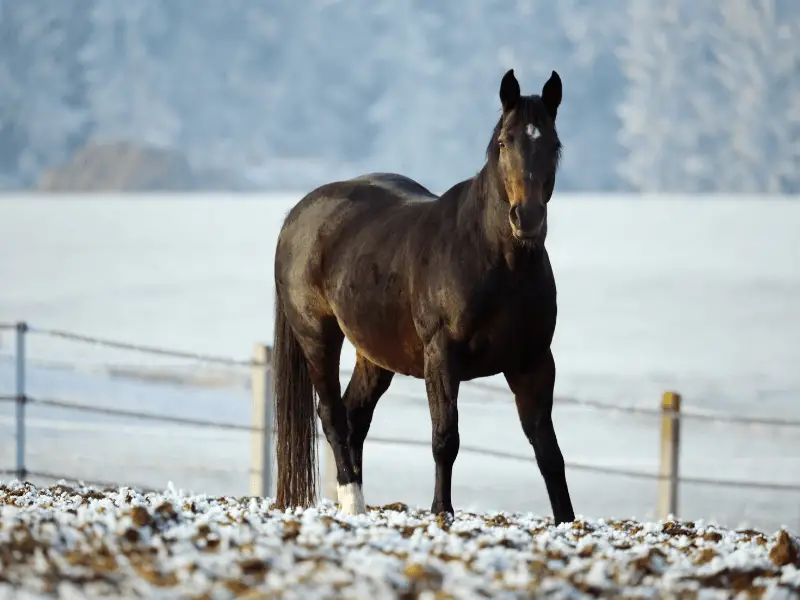
The Last Word on Equine Winter Defenses
By understanding your horse’s natural ability to withstand cold weather and providing appropriate support when needed, you can help your equine friend stay warm, healthy, and comfortable throughout the winter.
We’ve discussed the various ways horses stay warm in the winter, including their winter coat, digestion, movement, shelter, and huddling with other horses. Additionally, we covered the role of rugs and blankets and how to choose the right one for your horse’s specific needs.
As a responsible horse owner, monitor your horse’s comfort and well-being during the colder months, provide adequate nutrition and shelter, and consider using rugs or blankets when necessary to help your horse thrive in the winter season.
| Key Takeaways |
|---|
| 1. Horses have developed a set of physical and behavioral adaptations to stay warm in cold weather. |
| 2. The winter coat plays a significant role in insulation and retaining body heat. |
| 3. Horses have a thermoneutral zone, a temperature range in which they can maintain body heat without using extra energy. |
| 4. Rugs and blankets can provide additional warmth, but their use should be carefully considered. |
| 5. Digestion and fiber intake help generate internal heat for horses during winter. |
| 6. Body condition, movement, sunlight, and natural shelter play important roles in maintaining warmth. |
| 7. Horses may huddle together in herds for added warmth and protection. |
| 8. Cold weather challenges such as foot and leg care, circulation, and shivering should be addressed. |
| 9. The respiratory system contributes to warming air for the horse. |
| 10. Factors like wind chill, moisture, age, health status, breed, and access to nutrition and water all affect a horse’s comfort in cold weather. |
Frequently Asked Questions
Q: How cold is too cold for horses?
A: Horses can generally tolerate cold temperatures quite well, thanks to their winter coat and other adaptations. However, each horse has its own lower critical temperature (LCT), which is the lowest temperature at which a horse can maintain its core body temperature without using additional energy. Factors like breed, age, and body condition can affect a horse’s LCT. If you notice your horse shivering or showing other signs of discomfort in cold weather, it may be necessary to provide additional warmth through a rug or blanket.
Q: Can horses get frostbite?
A: While it’s relatively rare for horses to develop frostbite, they can be susceptible to it in extreme cold or when exposed to cold, wet conditions for extended periods. The most common areas for frostbite in horses are the ears, muzzle, and lower limbs. To protect your horse from frostbite, ensure they have access to shelter, provide a rug or blanket if necessary, and check them regularly for signs of cold-related issues.
Q: Should I keep my horse inside during the winter?
A: Horses can generally tolerate cold temperatures quite well, thanks to their winter coat and other adaptations. However, each horse has its own lower critical temperature (LCT), which is the lowest temperature at which a horse can maintain its core body temperature without using additional energy. Factors like breed, age, and body condition can affect a horse’s LCT. If you notice your horse shivering or showing other signs of discomfort in cold weather, it may be necessary to provide additional warmth through a rug or blanket.
Q: How can I tell if my horse is cold?
A: Pay attention to your horse’s behavior and physical condition. Signs that your horse may be too cold include shivering, lethargy, weight loss, or reluctance to move. If you notice any of these signs, consider providing additional warmth through a rug or blanket or increasing their calorie intake through additional hay or feed.
Q: How do I choose the right blanket or rug for my horse?
A: Choosing the right rug or blanket for your horse depends on several factors, including their size, breed, coat condition, and the specific weather conditions in your area. When selecting a rug, consider the weight, breathability, waterproofing, and fit to ensure your horse stays comfortable and warm. It’s also essential to regularly check and adjust the rug as needed to prevent rubbing or chafing.
Q: Do horses need heated water in the winter?
A: Providing access to fresh, unfrozen water is essential for your horse’s health and well-being throughout the winter months. Horses may be more likely to drink water that is not ice-cold, and heated water buckets or trough heaters can help prevent the water from freezing. Ensure that your horse has access to clean, fresh water at all times, and check their water source regularly to ensure it remains ice-free.
By learning about the natural defenses horses have to stay warm in winter, you’ll be better able to support their health and well-being during the colder months.
Cheers, Kacey
P.S. Did you like this article? Gallop over to:

